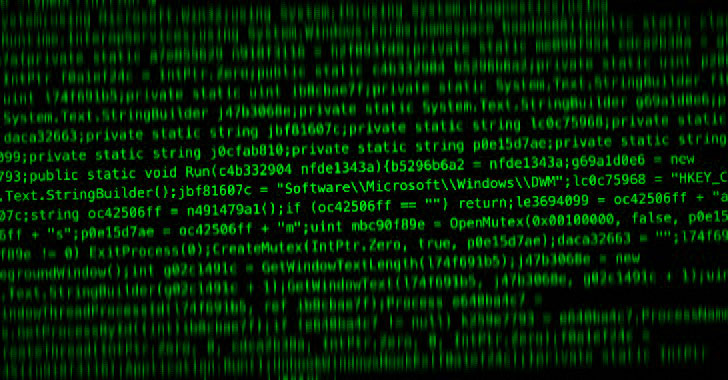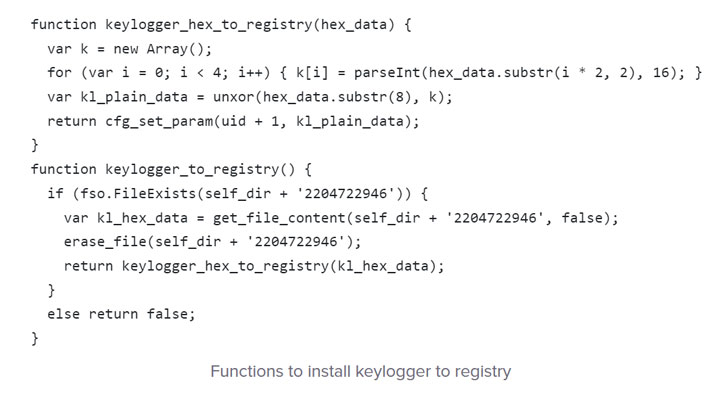Products You May Like
A new JavaScript-based remote access Trojan (RAT) propagated via a social engineering campaign has been observed employing sneaky “fileless” techniques as part of its detection-evasion methods to elude discovery and analysis.
Dubbed DarkWatchman by researchers from Prevailion’s Adversarial Counterintelligence Team (PACT), the malware uses a resilient domain generation algorithm (DGA) to identify its command-and-control (C2) infrastructure and utilizes the Windows Registry for all of its storage operations, thereby enabling it to bypass antimalware engines.
The RAT “utilizes novel methods for fileless persistence, on-system activity, and dynamic run-time capabilities like self-updating and recompilation,” researchers Matt Stafford and Sherman Smith said, adding it “represents an evolution in fileless malware techniques, as it uses the registry for nearly all temporary and permanent storage and therefore never writes anything to disk, allowing it to operate beneath or around the detection threshold of most security tools.”
Prevailion said that an unnamed enterprise-sized organization in Russia was one among the targeted victims, with a number of malware artifacts identified starting November 12, 2021. Given its backdoor and persistence features, the PACT team assessed that DarkWatchman could be initial access and reconnaissance tool for use by ransomware groups.
An interesting consequence of this novel development is that it completely obviates the need for ransomware operators to recruit affiliates, who are typically in charge of dropping the file-locking malware and handling the file exfiltration. Using DarkWatchman as a prelude for ransomware deployments also equips the core developers of the ransomware with better oversight over the operation beyond negotiating ransoms.
Distributed via spear-phishing emails that masquerade as “Free storage expiration notification” for a consignment delivered by Russian shipment company Pony Express, DarkWatchman provides a stealthy gateway for further malicious activity. The emails come attached with a purported invoice in the form of a ZIP archive that, in turn, contains the payload necessary to infect the Windows system.
The novel RAT is both a fileless JavaScript RAT and a C#-based keylogger, the latter of which is stored in the registry to avoid detection. Both the components are also extremely lightweight. The malicious JavaScript code just takes about 32kb, while the keylogger barely registers at 8.5kb.
“The storage of the binary in the registry as encoded text means that DarkWatchman is persistent yet its executable is never (permanently) written to disk; it also means that DarkWatchman’s operators can update (or replace) the malware every time it’s executed,” the researchers said.
Once installed, DarkWatchman can execute arbitrary binaries, load DLL files, run JavaScript code and PowerShell commands, upload files to a remote server, update itself, and even uninstall the RAT and keylogger from the compromised machine. The JavaScript routine is also responsible for establishing persistence by creating a scheduled task that runs the malware at every user log on.
“The keylogger itself does not communicate with the C2 or write to disk,” the researchers said. “Instead, it writes its keylog to a registry key that it uses as a buffer. During its operation, the RAT scrapes and clears this buffer before transmitting the logged keystrokes to the C2 server.”
DarkWatchman has yet to be attributed to a hacking group, but Prevailion characterized the crew as a “capable threat actor,” alongside pointing out the malware’s exclusive targeting of victims located in Russia and the typographical errors and misspellings that were identified in the source code samples, raising the possibility that the operators may not be native English speakers.
“It would appear that the authors of DarkWatchman identified and took advantage of the complexity and opacity of the Windows Registry to work underneath or around the detection threshold of security tools and analysts alike,” the researchers concluded. “Registry changes are commonplace, and it can be difficult to identify which changes are anomalous or outside the scope of normal OS and software functions.”



